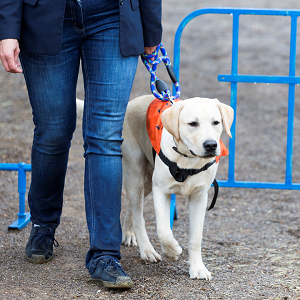Navigating Requests for Worksite Service Animals through the Interactive Process
 By Joanne B. Lambert, JD
By Joanne B. Lambert, JD
Office Managing Principal
Jackson Lewis, P.C.
Will you be ready when your employee insists on bringing Fluffy, a 95-pound German shepherd emotional support animal, to work? Is there a difference between an emotional support animal and a service animal? What is an employer required to do?
These questions and others have become more common in the wake of several highly-publicized attempts by people to board flights or enter public places with exotic animals. In one case an airline passenger attempted to board a flight with her emotional support peacock, which was properly denied by the airline.
Multiple laws govern various sites: places of public accommodation, public transportation, airlines, housing establishments, and public- and private-sector workplaces. Many state and local laws further expand service and support animal protections. Depending on location and the nature of the business, an employer might find itself subject to several or even all of these laws.
Sound confusing? It is, and the confusion can be compounded by coworker and customer reactions. Some of your employees may have a legitimate need for a service or support animal. Others just love their “fur babies” and will go to great lengths to bring them to work. Both employers and employees may also have inaccurate expectations based on misinformation they read on the internet or simply misunderstand that certain laws on this topic do not apply in the employment setting. Let’s look specifically at accommodating service or support animals in the workplace under the Americans with Disabilities Act (ADA).
Most employers are required by Title I of the ADA to reasonably accommodate employees with disabilities, absent undue hardship or direct threat of harm to others. This may include allowing service animals as a reasonable accommodation. While Title I does not mention service or emotional support animals at all, Title III of the ADA, which governs public access accommodations, specifically addresses service animals. Courts and agencies look to Title III for guidance on service animal accommodations in the workplace.
Service Animal or Support Animal?
Title III of the ADA defines a service animal as “any dog that is individually trained to do work or perform tasks for the benefit of an individual with a disability, including a physical, sensory, psychiatric, intellectual, or other mental disability.” The ADA also provides additional criteria for approving miniature horses as public access service animals, but all other animals are specifically excluded.
Full content is available to DMEC members only. to view the complete resource.
If you are not a DMEC member, we encourage you to join. DMEC members have access to white papers, case studies, @Work magazine articles, free webinars, legislative updates, and much more. These resources will assist you in building an effective and compliant integrated absence management program, saving you time, resources, and money. Learn more.
If you are being asked to log in more than once, please refresh your browser.



